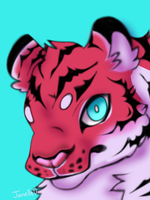Profile
Cyborg tiger
He/Him
Inspired by Unknown Brain & Hoober - Phenomenon
Most of his body is robotic. His fur, teeth, claws and bones are all mechanical and of man-made material. His heart and most of his brain are the only things organic and still functional in his body. His system has special antibiotics to keep the two bodily organs healthy.
He does not need to eat or drink, as he has no digestive system.
He does still feel emotions, since he still has his brain and heart.
His mechanical body operates entirely off of electrical signals coming from his brain. This requires a highly advanced robotic spinal cord able to send and recieve messages from the brain to other parts of the body within milliseconds.
I have not thought of his backstory yet. Stay tuned!
[Some brainstorming ideas for his story]
Ki-Mahri was a tiger taken from his habitat as a juvenile male. Many other tigers in his area were taken and all of them were brought to a special facility. The humans of this facility conducted experiments on the animals they collected, trying to find ways to conjoin biological parts with machine parts. This meant replacing missing legs, arms, or tails of the animals with advanced prosthetic limbs that weren't meant to be removed. They were connected to every nerve in the body, allowing the animal to now have feeling in its new metal limb.
After close to a century, the facility began having success with their experiments and physical tests on the animals and hatched a plan for the recent outbreak of plague in animals. This plague could only be spread between animals (most commonly mammals,) and started with a loss of fur, then the thinning of bone structure and skin, causing their limbs to slowly decay and fall off. In later stages, it spreads to the entire body, affecting parts of the torso and face. Organs are usually the last to be infiltrated by the virus, as the ribcage protects them and the virus infects from the outside in.
1981.
This plague broke out in a large rainforest, affecting animals on land and sea alike. Since humans are immune to the horrible condition, nothing is done to help or treat the animals in need. At this time, animal rescue agencies are very limited and small- not significant enough to make change.
Seven years later, in 1998, a hidden agency takes action and begins to try and create a cure. For many years, they failed, with more and more wildlife succumbing to the disease. Then finally, in the summer of 2006, the facility discovered a successful mixture that could alleviate the symptoms of decay. It wasn't a cure, but it was a good start. The facility would first save this solution in order to properly replicate it when needed, then over the years they produced gallons and gallons of it kept in safes.
2008
At this time, few agencies and businesses are taking notice of the problem and working on ways to fix the major loss of animals. It has begun to affect household pets and is now airborne. Families are saddened by the loss of their pets and begin to pressure authorities to fix the problem as it spreads quickly to other states.
2011
The virus has spread to three countries. Many people are worried, as experts have predicted that the virus could mutate and potentially infect children or the elderly- those who have weaker immune systems. Scientists cannot find the origin of the disease and advise people to beware of any animals that appear sickly. The condition is easily mistaken for mange. When a pet is brought to a veterinarian in these early stages, home remedies medicines can be used to treat the animal, although they can do nothing to prevent the condition from worsening. Upon knowing this, many people have their pets euthanized before it gets any worse, to "end their suffering."
2018
It is the season of autumn. The hidden facility, now well-prepared, takes out their plan to capture injured animals and restore their bodies back to health. Technology in this era is advanced, but still quite primitive when it comes to full-fledged prosthetic limbs. People have abandoned the very concept of owning mammalian pets, out of fear for losing them to the virus, newly named "The Blight Plague" by society. The facility continues to keep their treatment for the virus from the public, spending more time learning and experimenting to combat it.
2109
The virus has infected six continents. It is not able to survive in Antarctica. Most species of mammals have sadly succumb to extinction. The virus has not mutated in any way or form, so human immune systems are still unaffected. However, there has been a long struggle for dairy products. Many citizens have started their own farms, owning their own cows, chickens, and pigs to harvest. The supply of wool has also run very low, causing there to be a very small number of wool clothes being made.


